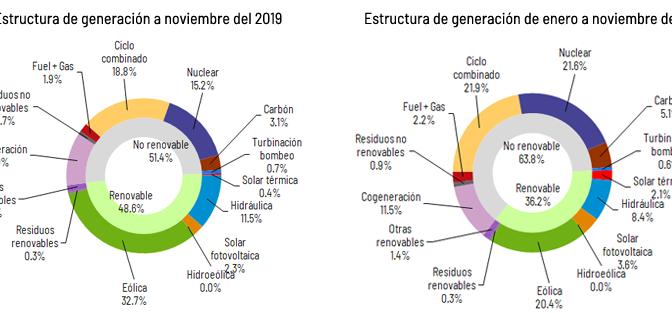Renewable energy covered 48.6% of electricity demand in November in Spain, wind power generated 32.7%, solar thermal 0.4% and photovoltaic 2.3%.

The demand for national electricity in November is estimated at 21,966 GWh, 0.4% lower than that registered in the same month of the previous year. If the effects of the calendar and temperatures are taken into account, the figure drops 1.3% compared to November 2018.
In the first eleven months of 2019, demand is estimated at 242,395 GWh, 1.7% less than in 2018. Again, once the influence of the calendar and temperatures has been corrected, demand is 2.7% lower to the one registered in the same period of the previous year.
In November and according to estimated data today, generation from renewable energy sources accounted for 48.6% of production. In the first eleven months the renewable generation reaches 36.2% of the total electric balance.
In this month 64.5% of electricity production came from technologies that do not emit CO2.
With information available today, wind production in November reached 7,396 GWh, 62.2% higher than the same period last year, and accounted for 32.7% of national production.
The demand for electrical energy drops 0.6% in the peninsular electricity system
In the peninsular electricity system, the demand for November is estimated at 20,785 GWh, 0.6% lower than that registered in the same month of the previous year. If the effects of the calendar and temperatures are taken into account, the figure drops 1.5% compared to November 2018.
In the first eleven months of 2019, the demand for electricity in the Peninsula is estimated at 228,199 GWh, 1.8% less than in 2018. Again, once the influence of the calendar and temperatures has been corrected, the demand is 2.9% lower than that registered in the same period of the previous year.
During this month and according to estimated data today, 50.4% of the peninsular generation was of renewable origin and 67.1% came from technologies that do not emit CO2. On the other hand, wind power registered 7,271 GWh, 60.6% higher than that of November last year, and contributed 33.8% to the mix.
The demand for electricity increases in the Balearic and Canary Islands in the month of November
In the Balearic Islands, the demand for electricity in November is estimated at 417,576 MWh, 5.3% higher than that registered in the same month of the previous year. If the effects of the calendar and temperatures are taken into account, the figure increases 1.7% compared to November 2018. In the first eleven months of 2019, the Balearic demand is estimated at 5,696,317 MWh, a 1, 1% more than in 2018.
Coal, with 41.4% of the total, was the first source of electricity generation in the Balearic Islands, where renewable technologies that do not emit CO2 accounted for 6.2%.
On the other hand, in the Canary archipelago the demand for electricity is estimated at 728,677 MWh, 1.1% higher than that registered in November 2018. If the effects of the calendar and temperatures are taken into account, the figure increases by 1 , 3% with respect to the same month of the previous year. From January to November, demand in the Canary Islands is estimated at 8,116,569 MWh and increases 0.2% over the same period of the previous year.
In the month of November and according to estimated data, the combined cycle was the leading technology in the Canarian generation mix, with a contribution of 32.2%. Renewables and emission-free technologies accounted for 19.2% of the Canarian generation.


